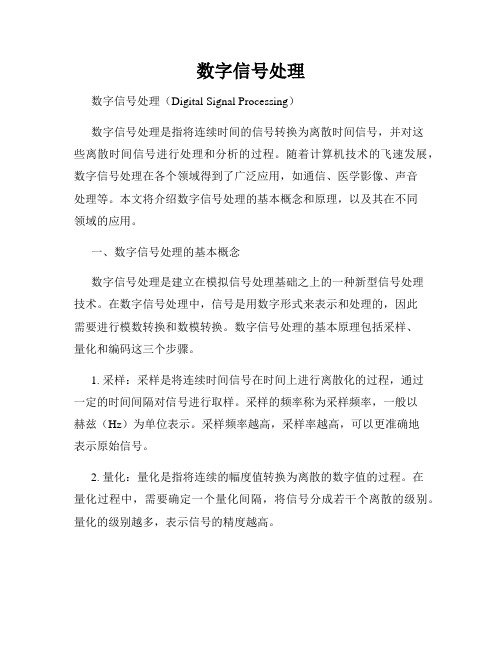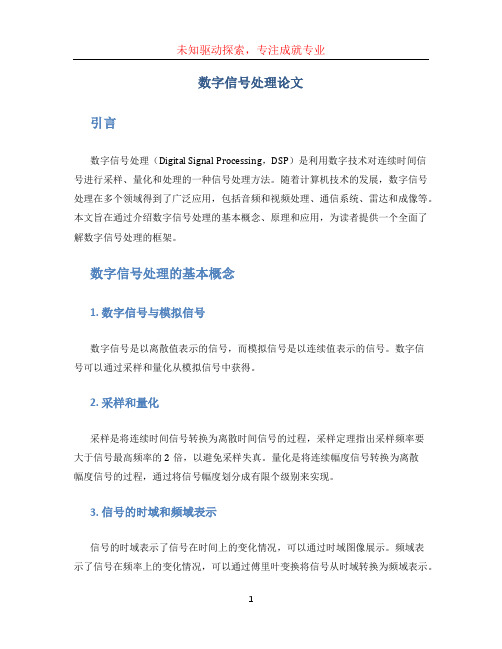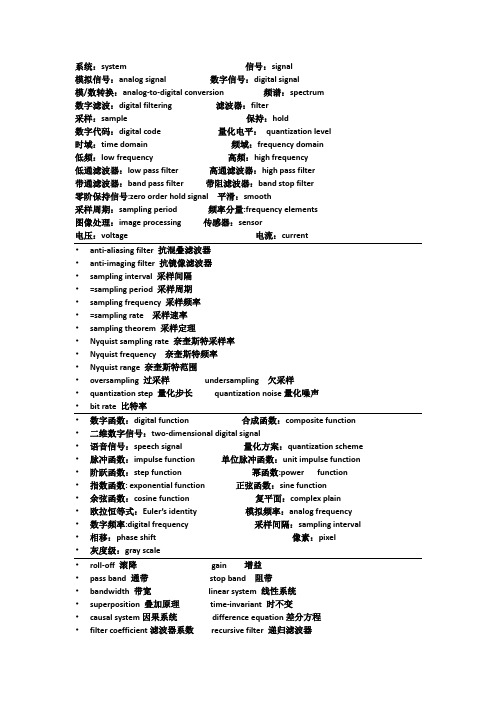数字信号处理外文翻译
数字信号处理 名词解释-概述说明以及解释

数字信号处理名词解释-概述说明以及解释1.引言1.1 概述数字信号处理(Digital Signal Processing,简称DSP)是一种广泛应用于信号处理领域的技术,它利用数字化的方式对连续时间信号进行处理和分析。
数字信号处理可以实现信号的滤波、频谱分析、模拟与数字信号的转换、信息编码解码等功能,是现代通信、音视频处理、生物医学领域等各个领域中不可或缺的技术手段。
通过数字信号处理技术,我们可以更加精确和高效地处理各种类型的信号,包括声音、图像、视频等。
数字信号处理可以使信号的处理过程更加稳定可靠,同时也可以方便地与计算机等数字系统进行集成,实现更多复杂功能。
在本篇文章中,我们将深入探讨数字信号处理的定义、应用领域以及基本原理,以期让读者对这一重要领域有更加全面的认识和理解。
1.2 文章结构本文将分为三个主要部分,分别是引言、正文和结论。
在引言部分,我们将对数字信号处理进行简要的概述,并介绍文章的结构和目的。
正文部分将详细讨论数字信号处理的定义、应用领域和基本原理。
最后,在结论部分,我们将总结数字信号处理的重要性,探讨未来数字信号处理的发展趋势,并做出最终的结论。
通过这样的结构安排,读者能够清晰地了解数字信号处理的基本概念、应用以及未来发展方向。
1.3 目的:本文旨在介绍数字信号处理的概念、应用领域和基本原理,旨在帮助读者更深入了解数字信号处理的重要性和作用。
通过对数字信号处理的定义和应用领域的介绍,读者可以了解数字信号处理在各个领域中的广泛应用和重要性。
同时,通过对数字信号处理的基本原理的讲解,读者可以更好地理解数字信号处理的工作原理和技术特点。
通过本文的阐述,希望读者能够全面了解数字信号处理的基本概念和工作原理,进而认识到数字信号处理在现代科学技术中的重要性和必要性。
同时,本文也将展望未来数字信号处理的发展趋势,希望能够启发读者对数字信号处理领域的进一步研究和探索。
最终,通过本文的阐述,读者可以更加深入地理解数字信号处理这一重要的科学技术领域。
专业英语翻译之数字信号处理

Signal processingSignal processing is an area of electrical engineering and applied mathematics that deals with operations on or analysis of signals, in either discrete or continuous time, to perform useful operations on those signals. Signals of interest can include sound, images, time-varying measurement values and sensor data, for example biological data such as electrocardiograms, control system signals, telecommunication transmission signals such as radio signals, and many others. Signals are analog or digital electrical representations of time-varying or spatial-varying physical quantities. In the context of signal processing, arbitrary binary data streams and on-off signalling are not considered as signals, but only analog and digital signals that are representations of analog physical quantities.HistoryAccording to Alan V. Oppenheim and Ronald W. Schafer, the principles of signal processing can be found in the classical numerical analysis techniques of the 17th century. They further state that the "digitalization" or digital refinement of these techniques can be found in the digital control systems of the 1940s and 1950s.[2]Categories of signal processingAnalog signal processingAnalog signal processing is for signals that have not been digitized, as in classical radio, telephone, radar, and television systems. This involves linear electronic circuits such as passive filters, active filters, additive mixers, integrators and delay lines. It also involves non-linear circuits such ascompandors, multiplicators (frequency mixers and voltage-controlled amplifiers), voltage-controlled filters, voltage-controlled oscillators andphase-locked loops.Discrete time signal processingDiscrete time signal processing is for sampled signals that are considered as defined only at discrete points in time, and as such are quantized in time, but not in magnitude.Analog discrete-time signal processing is a technology based on electronic devices such as sample and hold circuits, analog time-division multiplexers, analog delay lines and analog feedback shift registers. This technology was a predecessor of digital signal processing (see below), and is still used in advanced processing of gigahertz signals.The concept of discrete-time signal processing also refers to a theoretical discipline that establishes a mathematical basis for digital signal processing, without taking quantization error into consideration.Digital signal processingDigital signal processing is for signals that have been digitized. Processing is done by general-purpose computers or by digital circuits such as ASICs, field-programmable gate arrays or specialized digital signal processors (DSP chips). Typical arithmetical operations include fixed-point and floating-point, real-valued and complex-valued, multiplication and addition. Other typical operations supported by the hardware are circular buffers and look-up tables. Examples of algorithms are the Fast Fourier transform (FFT), finite impulseresponse (FIR) filter, Infinite impulse response (IIR) filter, and adaptive filters such as the Wiener and Kalman filters1.Digital signal processingDigital signal processing (DSP) is concerned with the representation of signals by a sequence of numbers or symbols and the processing of these signals. Digital signal processing and analog signal processing are subfields of signal processing. DSP includes subfields like: audio and speech signal processing, sonar and radar signal processing, sensor array processing, spectral estimation, statistical signal processing, digital image processing, signal processing for communications, control of systems, biomedical signal processing, seismic data processing, etc.The goal of DSP is usually to measure, filter and/or compress continuousreal-world analog signals. The first step is usually to convert the signal from an analog to a digital form, by sampling it using an analog-to-digital converter (ADC), which turns the analog signal into a stream of numbers. However, often, the required output signal is another analog output signal, which requires a digital-to-analog converter (DAC). Even if this process is more complex than analog processing and has a discrete value range, the application of computational power to digital signal processing allows for many advantages over analog processing in many applications, such as error detection and correction in transmission as well as data compression.[1]DSP algorithms have long been run on standard computers, on specialized processors called digital signal processors (DSPs), or on purpose-built hardware such as application-specific integrated circuit (ASICs). Today thereare additional technologies used for digital signal processing including more powerful general purpose microprocessors, field-programmable gate arrays (FPGAs), digital signal controllers (mostly for industrial apps such as motor control), and stream processors, among others.[2]2. DSP domainsIn DSP, engineers usually study digital signals in one of the following domains: time domain (one-dimensional signals), spatial domain (multidimensional signals), frequency domain, autocorrelation domain, and wavelet domains. They choose the domain in which to process a signal by making an informed guess (or by trying different possibilities) as to which domain best represents the essential characteristics of the signal. A sequence of samples from a measuring device produces a time or spatial domain representation, whereas a discrete Fourier transform produces the frequency domain information, that is the frequency spectrum. Autocorrelation is defined as the cross-correlation of the signal with itself over varying intervals of time or space.3. Signal samplingMain article: Sampling (signal processing)With the increasing use of computers the usage of and need for digital signal processing has increased. In order to use an analog signal on a computer it must be digitized with an analog-to-digital converter. Sampling is usually carried out in two stages, discretization and quantization. In the discretization stage, the space of signals is partitioned into equivalence classes and quantization is carried out by replacing the signal with representative signal of the corresponding equivalence class. In the quantization stage the representative signal values are approximated by values from a finite set.The Nyquist–Shannon sampling theorem states that a signal can be exactly reconstructed from its samples if the sampling frequency is greater than twice the highest frequency of the signal; but requires an infinite number of samples . In practice, the sampling frequency is often significantly more than twice that required by the signal's limited bandwidth.A digital-to-analog converter is used to convert the digital signal back to analog. The use of a digital computer is a key ingredient in digital control systems. 4. Time and space domainsMain article: Time domainThe most common processing approach in the time or space domain is enhancement of the input signal through a method called filtering. Digital filtering generally consists of some linear transformation of a number of surrounding samples around the current sample of the input or output signal. There are various ways to characterize filters; for example:∙ A "linear" filter is a linear transformation of input samples; other filters are "non-linear". Linear filters satisfy the superposition condition, i.e. if an input is a weighted linear combination of different signals, the output is an equally weighted linear combination of the corresponding output signals.∙ A "causal" filter uses only previous samples of the input or output signals; while a "non-causal" filter uses future input samples. A non-causal filter can usually be changed into a causal filter by adding a delay to it.∙ A "time-invariant" filter has constant properties over time; other filters such as adaptive filters change in time.∙Some filters are "stable", others are "unstable". A stable filter produces an output that converges to a constant value with time, or remains bounded within a finite interval. An unstable filter can produce an output that grows without bounds, with bounded or even zero input.∙ A "finite impulse response" (FIR) filter uses only the input signals, while an "infinite impulse response" filter (IIR) uses both the input signal and previous samples ofthe output signal. FIR filters are always stable, while IIR filters may be unstable.Filters can be represented by block diagrams which can then be used to derive a sample processing algorithm to implement the filter using hardware instructions. A filter may also be described as a difference equation, a collection of zeroes and poles or, if it is an FIR filter, an impulse response or step response.The output of a digital filter to any given input may be calculated by convolving the input signal with the impulse response.5. Frequency domainMain article: Frequency domainSignals are converted from time or space domain to the frequency domain usually through the Fourier transform. The Fourier transform converts the signal information to a magnitude and phase component of each frequency. Often the Fourier transform is converted to the power spectrum, which is the magnitude of each frequency component squared.The most common purpose for analysis of signals in the frequency domain is analysis of signal properties. The engineer can study the spectrum todetermine which frequencies are present in the input signal and which are missing.In addition to frequency information, phase information is often needed. This can be obtained from the Fourier transform. With some applications, how the phase varies with frequency can be a significant consideration.Filtering, particularly in non-realtime work can also be achieved by converting to the frequency domain, applying the filter and then converting back to the time domain. This is a fast, O(n log n) operation, and can give essentially any filter shape including excellent approximations to brickwall filters.There are some commonly used frequency domain transformations. For example, the cepstrum converts a signal to the frequency domain through Fourier transform, takes the logarithm, then applies another Fourier transform. This emphasizes the frequency components with smaller magnitude while retaining the order of magnitudes of frequency components.Frequency domain analysis is also called spectrum- or spectral analysis. 6. Z-domain analysisWhereas analog filters are usually analysed on the s-plane; digital filters are analysed on the z-plane or z-domain in terms of z-transforms.Most filters can be described in Z-domain (a complex number superset of the frequency domain) by their transfer functions. A filter may be analysed in the z-domain by its characteristic collection of zeroes and poles.7. ApplicationsThe main applications of DSP are audio signal processing, audio compression, digital image processing, video compression, speech processing, speech recognition, digital communications, RADAR, SONAR, seismology, and biomedicine. Specific examples are speech compression and transmission in digital mobile phones, room matching equalization of sound in Hifi and sound reinforcement applications, weather forecasting, economic forecasting, seismic data processing, analysis and control of industrial processes, computer-generated animations in movies, medical imaging such as CAT scans and MRI, MP3 compression, image manipulation, high fidelity loudspeaker crossovers and equalization, and audio effects for use with electric guitar amplifiers8. ImplementationDigital signal processing is often implemented using specialised microprocessors such as the DSP56000, the TMS320, or the SHARC. These often process data using fixed-point arithmetic, although some versions are available which use floating point arithmetic and are more powerful. For faster applications FPGAs[3] might be used. Beginning in 2007, multicore implementations of DSPs have started to emerge from companies including Freescale and Stream Processors, Inc. For faster applications with vast usage, ASICs might be designed specifically. For slow applications, a traditional slower processor such as a microcontroller may be adequate. Also a growing number of DSP applications are now being implemented on Embedded Systems using powerful PCs with a Multi-core processor.(翻译)信号处理信号处理是电气工程与应用数学领域,在离散的或连续时间域处理和分析信号,以对这些信号进行所需的有用的处理。
数字信号处理

数字信号处理数字信号处理(Digital Signal Processing,简称DSP)是一种通过算法对数字信号进行处理和分析的技术方法。
它广泛应用于音频、图像、视频、通信等领域,在现代科技发展中扮演重要角色。
本文将从数字信号处理技术的定义、应用领域、基本原理等角度进行探讨。
一、定义数字信号处理是指利用数字技术方法来处理和分析信号的过程。
相较于模拟信号处理,数字信号处理能够通过采样、量化和编码将连续时间信号转换为离散时间信号,然后利用计算机等设备对离散时间信号进行处理。
在数字信号处理中,信号被表示为数字序列,通过算法进行运算和处理。
二、应用领域数字信号处理在众多领域中都有着广泛的应用,下面列举几个典型的应用领域。
1. 音频处理音频处理是数字信号处理的重要应用之一。
通过对音频信号进行采样和处理,可以实现音频增强、噪声消除、音频编码等功能。
在音频设备、通信系统以及音乐制作等领域都离不开数字信号处理的技术支持。
2. 图像处理数字图像处理是应用数字信号处理技术处理图像的方法。
通过对图像进行采样和处理,可以实现图像增强、边缘检测、图像压缩等功能。
在计算机视觉、医学影像、卫星图像等领域得到广泛应用。
3. 视频处理视频处理是对视频信号进行处理和分析的过程。
通过对视频信号进行采样、编码和压缩,可以实现视频压缩、移动视频传输等功能。
在监控系统、视频会议等领域都离不开数字信号处理技术的支持。
4. 通信处理数字信号处理技术在通信领域中起到了至关重要的作用。
通过对数字信号进行调制、编解码、信道均衡等处理,可以提高通信系统的可靠性和传输效率。
在移动通信、卫星通信等领域都广泛应用了数字信号处理技术。
三、基本原理数字信号处理的基本原理包括信号采样、量化、编码、运算和重构等步骤。
1. 信号采样信号采样是将连续时间信号转换为离散时间信号的过程。
通过按照一定的时间间隔对信号进行采样,得到一系列取样值,用来表示原始信号。
2. 量化和编码信号量化是将连续时间信号中的幅度值转换为离散值的过程。
数字信号处理(英文版)0-引言

Introduction
Digital Signal Processing
Theory, method, algorithm
Digital Signal Processor
A kind of microprocessor used to implement digital signal processing algorithm
processor speed.
We still need analog processing
(2)Processing very high frequency signals
Analog system:may process microwave,
mini-meter-wave, even light wave signals.
Radar/Sonar
Cruise missile
Smart bomb from F117
Pattern recognization
Fingerprint distinguish
Why digital?
(1)Programmability
Analog system:Modify
hardware design.
MIPS TECHNOLOGIES, INC. AND TI ANNOUNCE A STRATEGIC
RELATIONSHIP
MOUNTAIN VIEW, CALIF. and DALLAS, TX (Feb. 16, 1999) -- MIPS Technologies, Inc. (NASDAQ: MIPS) and Texas Instruments (NYSE: TXN) announced today a relationship to provide TI access to MIPS Technologies' processor cores in support of TI's digital signal processor (DSP) System Level Integration (SLI) solutions.
数字信号处理 英语

数字信号处理英语Digital Signal Processing (DSP) is an essential technology used in various fields such as communication, media, control systems and audio signal processing. This technology uses algorithms to transform digital signals (numbers) into specific applications. In this article, wewill explore some common terminologies used in DSP in English.1. SamplingSampling is the process of converting a continuoussignal into a discrete signal. The sampled signal represents the original signal at specific intervals, known as the sampling frequency. The number of samples taken per unit time is called the sample rate. For example, in audio signal processing, the standard sample rate is 44.1 kilohertz (kHz), which means that the signal is sampled 44,100 times per second.2. QuantizationQuantization is the process of assigning a discretevalue to each sample. Each sample is rounded to the nearest value in a given set of discrete values. The interval between each value is known as the quantization step size. For example, in audio signal processing, the quantization stepsize is measured in bits. The most common quantization bitsize is 16 bits, which means that each sample can be represented by a 16-bit binary number.3. FilteringFiltering is the process of removing or attenuating specific frequencies in a signal. The filter can be designedto pass only the desired frequency range or to eliminate unwanted frequencies. There are two types of filters –analog filters and digital filters. Analog filters usepassive components such as capacitors and resistors, while digital filters use mathematical algorithms to process the signal.4. Fast Fourier Transform (FFT)The Fourier Transform is a mathematical technique usedto analyze signals in the frequency domain. FFT is aparticular algorithm that efficiently calculates the Fourier Transform of a discrete signal. It is widely used in digital signal processing to analyze and process signals in the frequency domain.5. Digital Signal Processors (DSPs)Digital Signal Processors (DSPs) are specialized microprocessors used to perform DSP operations. DSPs are used in devices such as cellphones, wireless modems, televisions, and audio devices. They are optimized for performing complex mathematical operations required in digital signal processing.In conclusion, digital signal processing has become an essential technology in many fields, from communications to audio signal processing. Understanding the terminologies used in DSP is vital in learning and applying this technology. The above-mentioned terminologies are some of the most common terms used in DSP, and having a good understanding of thesewill help you to get started in this exciting field.。
数字信号处理

数字信号处理数字信号处理(Digital Signal Processing)数字信号处理是指将连续时间的信号转换为离散时间信号,并对这些离散时间信号进行处理和分析的过程。
随着计算机技术的飞速发展,数字信号处理在各个领域得到了广泛应用,如通信、医学影像、声音处理等。
本文将介绍数字信号处理的基本概念和原理,以及其在不同领域的应用。
一、数字信号处理的基本概念数字信号处理是建立在模拟信号处理基础之上的一种新型信号处理技术。
在数字信号处理中,信号是用数字形式来表示和处理的,因此需要进行模数转换和数模转换。
数字信号处理的基本原理包括采样、量化和编码这三个步骤。
1. 采样:采样是将连续时间信号在时间上进行离散化的过程,通过一定的时间间隔对信号进行取样。
采样的频率称为采样频率,一般以赫兹(Hz)为单位表示。
采样频率越高,采样率越高,可以更准确地表示原始信号。
2. 量化:量化是指将连续的幅度值转换为离散的数字值的过程。
在量化过程中,需要确定一个量化间隔,将信号分成若干个离散的级别。
量化的级别越多,表示信号的精度越高。
3. 编码:编码是将量化后的数字信号转换为二进制形式的过程。
在数字信号处理中,常用的编码方式有PCM(脉冲编码调制)和DPCM (差分脉冲编码调制)等。
二、数字信号处理的应用1. 通信领域:数字信号处理在通信领域中具有重要的应用价值。
在数字通信系统中,信号需要经过调制、解调、滤波等处理,数字信号处理技术可以提高信号传输的质量和稳定性。
2. 医学影像:医学影像是数字信号处理的典型应用之一。
医学影像技术如CT、MRI等需要对采集到的信号进行处理和重建,以获取患者的影像信息,帮助医生进行诊断和治疗。
3. 声音处理:数字信号处理在音频处理和语音识别领域也有广泛的应用。
通过数字滤波、噪声消除、语音识别等技术,可以对声音信号进行有效处理和分析。
总结:数字信号处理作为一种新兴的信号处理技术,已经深入到各个领域中,并取得了显著的进展。
数字信号处理论文

数字信号处理论文引言数字信号处理(Digital Signal Processing,DSP)是利用数字技术对连续时间信号进行采样、量化和处理的一种信号处理方法。
随着计算机技术的发展,数字信号处理在多个领域得到了广泛应用,包括音频和视频处理、通信系统、雷达和成像等。
本文旨在通过介绍数字信号处理的基本概念、原理和应用,为读者提供一个全面了解数字信号处理的框架。
数字信号处理的基本概念1. 数字信号与模拟信号数字信号是以离散值表示的信号,而模拟信号是以连续值表示的信号。
数字信号可以通过采样和量化从模拟信号中获得。
2. 采样和量化采样是将连续时间信号转换为离散时间信号的过程,采样定理指出采样频率要大于信号最高频率的2倍,以避免采样失真。
量化是将连续幅度信号转换为离散幅度信号的过程,通过将信号幅度划分成有限个级别来实现。
3. 信号的时域和频域表示信号的时域表示了信号在时间上的变化情况,可以通过时域图像展示。
频域表示了信号在频率上的变化情况,可以通过傅里叶变换将信号从时域转换为频域表示。
数字信号处理的原理1. 傅里叶变换和逆变换傅里叶变换是将信号从时域转换为频域的一种数学工具。
通过傅里叶变换,我们可以将信号的频域特性分析出来,以便进行后续的处理。
逆变换则是将频域信号重新转换回时域信号。
2. 滤波器设计滤波器是数字信号处理中常用的一种工具,用于增强或抑制信号的特定频率成分。
滤波器可以分为低通滤波器、高通滤波器、带通滤波器和带阻滤波器等不同类型。
滤波器设计的目标是使得滤波器在频域上满足一定的要求,通常使用巴特沃斯、切比雪夫等方法来实现。
3. 时域和频域处理算法数字信号处理中有许多常见的时域和频域处理算法,如加法、减法、乘法、卷积、相关等。
这些算法可以对信号进行的处理包括增加、减少、平滑、增强等各种操作。
数字信号处理的应用1. 音频和视频处理数字信号处理在音频和视频处理中有着广泛的应用。
例如,音频信号处理可以用于音频的音质改进、语音识别、音频压缩等。
数字信号处理(DSP)专业词汇

系统:system 信号:signal模拟信号:analog signal 数字信号:digital signal模/数转换:analog-to-digital conversion 频谱:spectrum数字滤波:digital filtering 滤波器:filter采样:sample 保持:hold数字代码:digital code 量化电平:quantization level时域:time domain 频域:frequency domain低频:low frequency 高频:high frequency低通滤波器:low pass filter 高通滤波器:high pass filter带通滤波器:band pass filter 带阻滤波器:band stop filter零阶保持信号:zero order hold signal 平滑:smooth采样周期:sampling period 频率分量:frequency elements图像处理:image processing 传感器:sensor电压:voltage 电流:current•anti-aliasing filter 抗混叠滤波器•anti-imaging filter 抗镜像滤波器•sampling interval 采样间隔•=sampling period 采样周期•sampling frequency 采样频率•=sampling rate 采样速率•sampling theorem 采样定理•Nyquist sampling rate 奈奎斯特采样率•Nyquist frequency 奈奎斯特频率•Nyquist range 奈奎斯特范围•oversampling 过采样undersampling 欠采样•quantization step 量化步长quantization noise量化噪声•bit rate 比特率•数字函数:digital function 合成函数:composite function •二维数字信号:two-dimensional digital signal•语音信号:speech signal 量化方案:quantization scheme •脉冲函数:impulse function 单位脉冲函数:unit impulse function •阶跃函数:step function 幂函数:power function •指数函数: exponential function 正弦函数:sine function•余弦函数:cosine function 复平面:complex plain•欧拉恒等式:Euler’s identity 模拟频率:analog frequency •数字频率:digital frequency 采样间隔:sampling interval •相移:phase shift 像素:pixel•灰度级:gray scale•roll-off 滚降gain 增益•pass band 通带stop band 阻带•bandwidth 带宽linear system 线性系统•superposition 叠加原理time-invariant 时不变•causal system因果系统difference equation差分方程•filter coefficient滤波器系数recursive filter 递归滤波器•nonrecursive filter 非递归滤波器finite word length effect有限字长效应•impulse response 脉冲响应infinite impulse response (IIR)无限脉冲响应•finite impulse response (FIR)有限脉冲响应•moving average filter 滑动平均滤波器•step response 阶跃响应•z transform z变换•region of convergence 收敛域•inverse z transform 逆z变换•transfer function 传输函数•partial fraction expansion 部分分式展开•cover-up method 覆盖法•zero 零点pole 极点•marginally stable 临界稳定unstable 不稳定•傅立叶变换:Fourier Transform•滤波器形状:filter shape•频率响应:frequency response•频率特性:frequency characteristics•离散时间傅立叶变换:Discrete Time Fourier Transform•幅度响应:magnitude response•相位响应:phase response•传输函数:transfer function•相位差:phase difference•采样频率:sampling frequency•white noise 白噪声•magnitude spectrum 幅度频谱•phase spectrum 相位频谱•discrete Fourier series(DFS)离散傅里叶级数•有限脉冲响应滤波器:finite impulse response filter•无限脉冲响应滤波器:infinite impulse response filter•相位失真:phase distortion•理想低通滤波器:idle low pass filter•窗函数:window function 稳定性:stability•通带波纹:pass band ripple•阻带波纹:stop band ripple•通带边缘频率:pass band edge frequency•过渡带宽度:transition width•矩形窗:Rectangular Window•汉宁窗:Hanning Window•哈明窗:Hamming Window•布莱克曼窗:Blackman Window•凯塞窗:Kaiser Window•项数:number of terms 衰减:attenuation•增益:gain•采样频率:sampling frequency•infinite impulse response filter(IIR)无限脉冲响应滤波器•bilinear transformation 双线性变换•prewarping equation 预扭曲方程•Butterworth filter 巴特沃斯滤波器•Chebyshev Type I filter 切比雪夫I 型滤波器•Chebyshev Type II filter 切比雪夫II 型滤波器•elliptic filter 椭圆滤波器•Impulse invariance method 脉冲响应不变法•discrete Fourier transform (DFT) 离散傅里叶变换•inverse DFT 逆离散傅里叶变换•phase spectrum 相位频谱•frequency spacing频率间隔•resolution分辨率•smear模糊•spectral leakage 频谱泄漏•spectrogram频谱图•fast Fourier transform (FFT) 快速傅里叶变换•butterfly 蝶形。
- 1、下载文档前请自行甄别文档内容的完整性,平台不提供额外的编辑、内容补充、找答案等附加服务。
- 2、"仅部分预览"的文档,不可在线预览部分如存在完整性等问题,可反馈申请退款(可完整预览的文档不适用该条件!)。
- 3、如文档侵犯您的权益,请联系客服反馈,我们会尽快为您处理(人工客服工作时间:9:00-18:30)。
毕业设计(论文)外文资料翻译专业:自动化姓名:学号:外文题目:The Breadth and Depth of DSP外文出处:The Scientist and Engineer's Guideto DSP1 DSP的广度和深度数字信号处理是最强大的技术,将塑造二十一世纪的科学与工程之一。
革命性的变化已经在广泛的领域:通信,医疗成像,雷达和声纳,高保真音乐再现,石油勘探,仅举几例。
上述各领域已建立了深厚的DSP技术,用自己的算法,数学,和专门技术。
这种呼吸和深度的结合,使得它不可能为任何一个人掌握所有已开发的DSP技术。
DSP教育包含两个任务:学习一般适用于作为一个整体领域的概念,并学习您感兴趣的特定领域的专门技术。
本章开始描述DSP已在几个不同领域的戏剧性效果的数字信号处理的世界,我们的旅程。
革命已经开始。
1.1 DSP的根源独特的数据类型,它使用的信号,数字信号处理是区别于其他计算机科学领域。
在大多数情况下,这些信号源于感觉来自现实世界的数据:地震的震动,视觉图像,声波等DSP是数学,算法,并用来操纵这些信号的技术后,他们已被转换成数字形式。
这包括了各种目标,如:加强视觉图像识别和语音生成,存储和传输的数据压缩,等假设我们重视计算机模拟 - 数字转换器,并用它来获得一个现实世界的数据块。
DSP回答了这个问题:下一步怎么办?DSP的根是在20世纪60年代和70年代数字计算机时首次面世。
电脑是昂贵的,在这个时代,DSP是有限的,只有少数关键应用。
努力开拓,在四个关键领域:雷达和声纳,国家安全风险是石油勘探,可以大量资金;太空探索,其中的数据是不可替代的;和医疗成像,可节省生活。
20世纪80年代和90年代的个人电脑革命,引起新的应用DSP的爆炸。
而不是由军方和政府的需求动机,DSP 的突然被带动的商业市场。
任何人士如认为他们可以使资金在迅速扩大的领域突然一个DSP供应商。
DSP的市民等产品达到:移动电话机,光盘播放器,电子语音邮件。
这一技术革命,从自上而下的发生。
在20世纪80年代初,DSP是研究生水平的课程,在电气工程教授。
十年后,DSP已成为标准的本科课程的一部分。
今天,DSP是一种在许多领域的科学家和工程师所需要的基本技能。
作为一个比喻,DSP可以比以前的技术革命:电子。
虽然仍是电气工程领域,几乎所有的科学家和工程师有一些基本的电路设计的背景。
没有它,他们将失去在科技世界。
DSP 具有相同的未来。
这最近的历史是超过了好奇,它有一个巨大的影响你的学习能力和使用DSP。
假设你遇到一个DSP的问题,并把课本或其他出版物,以找到一个解决方案。
你通常会发现什么是页后页方程,模糊的数学符号,不熟悉的术语。
这是一场恶梦! DSP的文献多是令人费解,甚至在该领域经验丰富的。
这并不是说有什么错用这种材料,它只是一个非常特殊的观众。
国家的最先进的研究人员需要这种详细的数学理解的工作的理论意义。
这本书的一个基本前提是,可以学到最实用的DSP技术,并没有详细的数学和理论的传统障碍。
科学家和工程师的数字信号处理指南是写给那些想要使用DSP作为一种工具,而不是一个新的职业生涯。
本章的其余部分说明,其中DSP已经产生了革命性的变化的地区。
当你通过每个应用程序,请注意,DSP是非常跨学科,依托在许多相邻领域的技术工作。
正如图。
如果你想专注于DSP,这是多领域,则还需要研究。
1.2 通信通信是信息传输从一个位置到另一个。
这包括各种形式的信息:电话交谈,电视信号,计算机中的文件,和其他类型的数据。
传输信息,你需要在两个地点之间的通道。
这可能是一个线对无线电信号,光纤等电信公司接收他们的客户的信息转移支付,而他们一定要以建立和维护渠道。
金融的底线很简单:信息越多,他们可以通过一个单一的通道,他们更多的钱。
DSP已彻底改变电信业在许多领域:信号音的产生和检测,频带的转移,过滤,除去电源线的嗡嗡声,从电话网络等具体的例子将在这里讨论:复用,压缩和回声控制。
1.2.1 复用在世界上大约有10亿电话。
在按几个按钮,开关网络允许其中任何一项,只有几秒钟的任何其他连接。
这项任务的艰巨,是超乎想象!直到20世纪60年代,两个电话之间的连接需要通过机械开关和放大器的模拟语音信号。
一个连接需要一对导线。
相比之下,DSP音频信号转换成串行数字数据流。
由于位可以轻松地交织在一起,后来分开,很多电话交谈可以传输渠道单一。
例如,一个电话标准,被称为T载波系统可以同时传送24个语音信号。
每个语音信号进行采样,每秒8000次,使用一个8位集成的(对数压缩)模拟到数字的转换。
这个结果在64,000比特/秒,所有24个被包含在1.544兆比特/秒的渠道代表每个语音信号。
这个信号可以传输,使用普通电话线,22号铜线,一个典型的互连距离约6000英尺。
数字传输的资金优势是巨大的。
线和模拟开关是昂贵的数字逻辑门价格便宜。
1.2.2 压缩当语音信号数字化,在8000样本/秒,大多数的数字信息是多余的。
也就是说,任何一个样本进行信息主要由邻近的样品重复。
DSP算法已发展到几十个数字化语音信号转换成数据流,需要较少的比特/秒。
这些被称为数据压缩算法。
匹配解压缩算法,用于恢复其原来的形式的信号。
这些算法不同的金额达到压缩和音质。
在一般情况下,减少64千比特/秒的数据传输速率为32千比特/秒的结果,在不损失音质。
当压缩到8千比特/秒的数据传输速率,声音明显受到影响,但仍然可用的长途电话网络。
达到的最高压缩约2千比特/秒,高度扭曲的声音,但可用于某些应用,如军事和海底通信。
1.2.3 回声控制回声是一个严重的问题,在长途电话连接。
当你走进一个电话,你的声音信号传播连接的接收器,它的一部分返回的回声。
如果连接是几百公里内,接收回声所用的时间只有几毫秒。
人类的耳朵习惯于听到这些小的时间延迟的回声,连接听起来很正常。
随着距离变大,回声变得越来越明显和刺激性。
延迟是几百毫秒洲际通信,特别是反感。
数字信号处理攻击这类型的问题,通过测量返回信号,并产生适当的反信号取消违规回声。
同样的技术,允许免提电话用户听取和不战而音频反馈(啸)在同一时间发言。
它也可用于减少环境噪声,取消它与数字产生抗噪。
1.3 音频处理主要的两个人的感官是视觉和听觉。
相应地,许多DSP的有关图像和音频处理。
人们听音乐和语音。
DSP已经在这两个领域取得了革命性的变化。
1.3.1 音乐从音乐家的麦克风,高保真的扬声器的路径是相当长。
数字数据表示,重要的是要防止通常与模拟存储和操作相关的退化。
这是非常熟悉的人与光盘,录音带的音乐素质。
在一个典型的场景,音乐作品在多个频道或曲目的录音室录制。
在某些情况下,这甚至涉及个别乐器和歌手分别记录。
这样做是为了给录音师更大的灵活性,创造的最终产品。
被称为复杂的过程,结合到最终产品的个别曲目的缩混。
DSP可以在组合提供几个重要的功能,包括:过滤,加法和减法信号,信号的编辑,等等。
最有趣的音乐准备的DSP应用之一是人工混响。
如果各个渠道的简单相加,导致一块听起来体弱及摊薄,音乐家多,如果在户外玩耍。
这是因为听众都深受影响的音乐,通常是在录音室最小的回声或混响内容。
DSP允许人造回声和混响加在混合模拟各种理想的听音环境。
几百毫秒延迟的回声,给像位置的大教堂的印象。
10-20毫秒的延迟添加回声提供更多的适度规模聆听室的看法。
1.3.2 语音生成语音生成和识别被用于人类和机器之间的沟通。
而不是用你的双手和眼睛,你用你的嘴和耳朵。
当你的手和眼睛应做别的东西,如:驾驶汽车,进行手术,或不幸敌人发射你的武器,这是非常方便。
两种方法用于计算机生成的讲话:数码录音和声道模拟。
在数码录音,一个人的扬声器的声音数字化处理和储存,通常在压缩形式。
在播放过程中,存储的数据压缩和转换成模拟信号。
整个小时的录音讲话要求只有约3兆字节的存储空间,即使是小规模的计算机系统内的功能。
这是今天使用的数字语音代最常用的方法。
声道模拟器比较复杂,试图模仿人类创造讲话的物理机制。
人类声道是声腔与商会的大小和形状确定的共振频率。
声音源于声道声和摩擦音,在两种基本方式之一。
浊音,声带振动产生周期脉冲附近的空气进入声乐腔。
相比之下,摩擦音源于在嘈杂的空气湍流,如牙齿和嘴唇,窄缢。
声道模拟器操作产生类似于激发这两种类型的数字信号。
共鸣腔的特点是通过类似共振的激励信号,通过数字滤波器的模拟。
这种方法是在一个非常早期的DSP成功故事,讲拼写,广泛销售的儿童电子学习援助。
1.3.3 语音识别人类语音的自动识别是非常多讲话一代困难。
语音识别是一个经典的东西,人类的大脑好例子,但数码电脑做的很差。
数码电脑可以存储和调用大量数据,在炽烈速度执行数学计算,并没有变得无聊或低效重复的任务。
不幸的是,现今电脑执行得非常糟糕时,面临着与原始的感官数据。
教学计算机发送给您每月的电费是很容易的。
在同一台计算机教学,以了解你的声音,是一大创举。
数字信号处理一般接近语音识别的问题,在两个步骤:特征提取,特征匹配。
传入的音频信号中的每个单词是孤立的,然后分析激发和共鸣频率识别的类型。
这些参数与前面的例子中,找出最接近的说话。
通常情况下,这些系统只有几百字的限制,只能接受具有鲜明的字与字之间的停顿的讲话,以及必须为各扬声器培训。
虽然这是许多商业应用提供足够的,这些限制是震撼人心相比,人类的听觉能力。
有巨大的财政奖励那些生产成功的商业产品,要在这方面做的大量工作。
1.4 回声定位一个常用的方法是获得远程对象的信息,超生波的关闭。
例如,雷达通过发射无线电波脉冲,并从飞机回声检查接收到的信号。
声纳,通过水传播的声波探测潜艇和其他水下物体。
地球物理学家已经长探测地球所设置的爆炸和听回声从岩石层深埋。
虽然这些应用都有一个共同的线程,每个人都有自己的具体问题和需求。
数字信号处理,在所有这三个领域产生革命性的变化。
1.4.1 雷达雷达是无线电探测和测距的缩写。
在最简单的雷达系统,无线电发射机产生的无线电频率能量的脉冲长几微秒。
此脉冲被送入一个高度定向天线,以光的速度在产生的无线电波传播距离。
飞机在这一波的路径将反映能源回向接收天线的一小部分,位于附近的传输站点。
脉冲传输和接收到的回波之间的运行时间从计算到物体的距离。
发现对象的方向更简单地说,你知道你指出的定向天线时收到回音。
经营范围的雷达系统是由两个参数决定:多少能源是在初始脉冲,无线电接收机的噪声水平。
不幸的是,增加脉冲能量通常需要较长的脉搏。
反过来,在较长的脉冲减少经过时间的测量准确度和精密度。
这两个重要参数之间的冲突结果:能够在远距离探测的对象,并能准确地判断一个对象的距离。
DSP具有革命性的雷达三个方面,所有这些都涉及到这个基本问题。
首先,DSP可以压缩后收到的脉冲,提供更好的距离决心,没有减少的经营范围。
